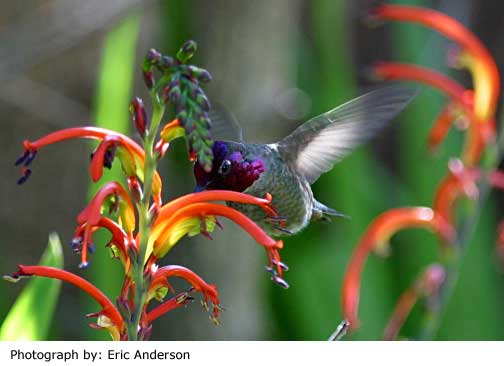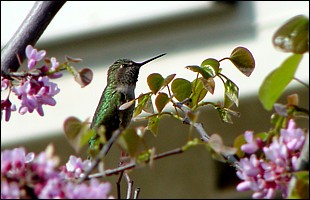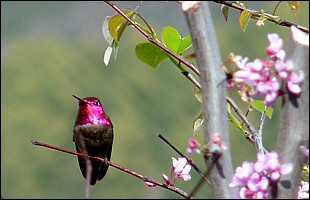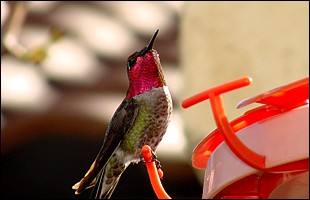
Hummers from tropic climes can be truly lush


Here in sunny San Diego, we are priviledged to be infested with a hummingbird population as thick as bees. Most of these are Anna's Hummingbird, but other species, often from farther south, do make appearances also.
Anna's are about 2 inches long in the body, plus a ¾-inch needle beak, with a wingspan of about 3 to 3 ½ inches. The males have a metallic green back, a metallic lavender-red cap, and 'bib' of the same metallic lavender-red color. Their bellies and wings are a pale grey, and the tailfeathers a somewhat darker grey often with a white "flash" on either side of the fanned-out tail. The females are medium or light gray with metallic green on the back. Individual birds vary in their coloration, some have more, some have less of the bright metallic coloration, be they male or female. At the feeder, the males' caps and bibs actually look black most of the time. Only if they raise the feathers, and/or the sun hits them just right, is the glint of lavender/red visible.
Fans of Star Wars will recognize the sound of a hummingbird's wings as being very similar to that of a lightsaber. Like the lightsaber, the wings emit a low, soft hum when the bird hovers still, with louder "zzooms" when it changes position. This is coincidence, however; according to an interview in Star Wars Insider, the movie's sound engineer, Ben Burtt, based the lightsaber's sound on several electronic gadgets, not on hummingbirds.
Hummingbirds, at least Anna's hummingbirds, are also quite vocal. They speak in high, squeaky, grasshoppery little voices. The males will perch on a high bare twig and declare their dominion to the entire surrounding acre: "B'zie Die Lieber, B'zie Die Lieber, Zwicke, Zwicke." In air battles, a loud "zickerzickerzicker" is their battle cry. At the feeder, even a hummer with only a gardening human for company, will emit periodic "chips" in time to its movements, and will often come over to investigate the nearby gardener. The sight of a bold Anna's hummingbird, that needle beak pointed face-on, darting back and forth in front of, and sometimes toward, one's face, punctuating each dart with a sharp "chip", all at a range of 2 feet or less, is enough to make one wish for safety glasses.
Thank goodness they are only 2 inches long! These little suckers are mean. They are probably one of the fiercest bird species I have ever seen, putting even fighting cocks to shame. Hummingbird air wars are legendary in San Diego, with two, often 3 or even 4 irate birds chasing each other about the sky. Those pictures on the hummingbird feeder boxes, with 5 or 6 hummers gathered about the feeder? Don't believe it for a second. Around here, it is one tiger to a hill, and one hummer to a food source, and the hummers enforce this rule religiously. Hummer + Feeder + Hummer = Fight.
If, after reading all this, you still have the courage to feed these fierce little beasts,
you will find it not difficult at all, at least in the southwestern corner of the U.S.
Buy any hummingbird feeder from the store that pleases you. If you can, try to
get one which has a mouth large enough to slip a baby-bottle brush through, as this will make
it easier to clean. Pesky-Pet, er Perky-Pet, makes a
"starter" or "trainer" feeder which is simply a straight tube with a cap-- this is the
easiest to clean I have seen yet. It only holds 3 ounces or so, but as we will see, that
is not a hindrance.
Do not waste your money on the little boxes of "hummingbird food" you find in the pet section. This is simply red-dyed sugar, and plain granulated sugar will do just as well, and not stain your carpet on the way to the patio, to boot.
You will need to remember that sanitation is key to feeding hummingbirds. The sugar water is a natural culture medium and nasty things will grow in it readily if you are not careful. Fortunately, it is no harder to keep things sanitary for the hummingbirds than it is to keep them sanitary for yourself. Think "baby bottles" if you need a rule of thumb.
Set aside a glass container, such as an old food jar, in which you will store the "brewed-up" hummer food. A good batch of hummer juice is 1/4 to 1/3 cup of granulated sugar in the storage container, and then fill it up the rest of the way with about 1- 1 1/3 cup water. A 1:4 ratio of sugar to water is good. Stir briskly to get the mix mixing, and then throw it in the microwave on full for about 3 minutes. You want to get it good and hot, to the point of boiling. This will kill any germs in the mix and let it keep longer. Nuking it in the container will serve to kill any germs on the container too. Once out of the microwave, cap it and put it in the fridge until it is time to use it. A batch this size is best, as larger batches can spoil before the hummers can drink it all, even when stored in the fridge.
The feeder should be rinsed out at every refill of food with the hottest water that will come out of the faucet. This at minimum; even better, scrub it out with dish soap and hot water, and rinse thoroughly, at every food refill. This is where a simply-shaped feeder, with all of its parts easily reachable by bottle brush, becomes really handy.
You want to put fresh food in the feeder at least once per week, as after that, even in spite of your cleanliness efforts, microscopic colonies can start to grow in the sugar water. A small feeder is a plus here, as the hummers will empty it out in less than a week, and none will go to waste.
Ants are a bane of hummingbird feeders in San Diego. An ideal solution is to suspend the feeder from a thick wire, such as coathanger wire or 14AWG electrician's wire. Smear the long straight middle of the wire with a thick coating of petroleum jelly, which may be mixed with citronella oil, leaving ~4 inches at either end un-coated for easier handling.. Ensure the feeder hangs free, not touching any vegetation, or anything else other than the suspending wire. The Vaseline coating will need to be renewed once a year or so, in non-rainy climates.


 Back to Crocuta Main
Back to Crocuta Main |
